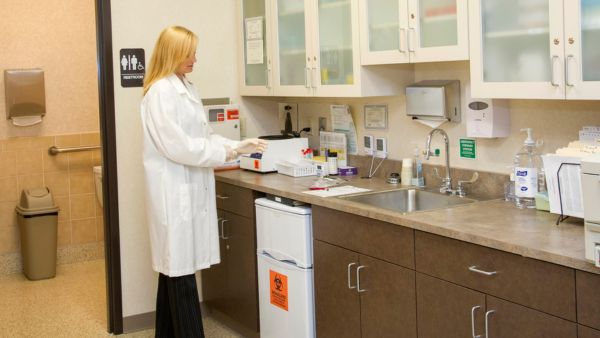Healthcare Facilities: Break Through Chemical-Management Challenges
Tricia Hodkiewicz, Editor - EHS
September 19, 2023

You’ll find hazardous chemicals “everywhere” you turn at your healthcare facility — the operating room, radiology, laundry, maintenance, laboratory, food services, and even office areas. These chemicals include everything from anesthetic gases, cancer-fighting agents, and cleaning solvents to compressed gases, flammables, and pesticides.
Yet, managing these healthcare-facility chemicals can be difficult for many reasons:
- Hundreds of regulations — Hazardous chemicals are governed by multiple federal, state, and local agencies, as well as accreditation organizations, industry standards, and permits. The sheer volume of requirements can make chemical compliance a struggle. Worse yet, these requirements can conflict with each other!
- Chemicals have stages — The lifespan of hazardous chemicals includes manufacturing, packaging, labeling/marking, shipping/transportation, storage, using/handling, emergency response, treatment, and disposal. Each stage can be regulated.
- Contractors make visits — Contractors may bring hazardous chemicals to your healthcare facility, impacting your own chemical management program, your patients, and staff. Contractors that enter your facility may be exposed to your chemicals too.
- Technical nature of chemicals — Chemical properties and the “chemistry” of chemicals can be highly technical, and a single chemical may pose more than one hazard.
- Consequences of mismanagement — Mismanaging chemicals can bring devastating consequences, such as serious injuries/illness, fatalities, property and/or environmental damage, suspension of operations, hefty fines, loss of accreditation and funding, hiked insurance premiums, eroded public confidence, and poor patient-satisfaction scores.
Take a centralized approach
Traditionally, chemical management has taken a siloed approach, where healthcare facilities adhered to each set of requirements separately. However, this creates inefficiencies, and your leadership team that oversees chemical management can quickly get overwhelmed.
Note that your primary objective in chemical management is to assure that your patients continue to get quality care, your staff is protected, your facility is safe, and the environment is kept from harm. Put another way, safety (and health) is your core driver.
Therefore, you may wish to combine the chemical lifecycle with effective safety principles to ensure a centralized approach to chemical management. Consider these management elements:
- Hazard identification and analysis — Identify and analyze your chemicals, chemical processes, and their hazards before purchasing new chemicals. Think about how a new purchase will change your healthcare facility.
- Acquisition — This involves the approval and purchase of chemicals to come onsite, along with chemicals supplied by subcontractors. Chemical reuse is preferred over new purchases. Also, contemplate smaller quantities and less-hazardous substitutes. Also, when chemicals arrive, ensure proper labeling and the receipt of safety data sheets.
- Chemical inventory management and tracking — It’s best practice to automate your inventory tracking system so it offers electronic inventory records of all chemicals onsite. At the same time, verify its accuracy with periodic facility walkthroughs.
- Chemical storage – Investigate chemical quantities, incompatibilities, and shelf lives before selecting chemical storage locations at your healthcare facility. Bear in mind that storage includes all chemicals, including used and unused chemicals; sealed, opened, or partially filled chemical containers; and chemicals in piping.
- Hazard control – Follow a hierarchy of controls. First, try to eliminate a chemical hazard through chemical substitution or process modification, when practical. Then, opt for engineering controls, followed by administrative controls. If those measures are not feasible or don’t fully eliminate the hazard, then personal protective equipment may be required.
- Pollution prevention and waste minimization – Identify opportunities to reduce pollution and waste. Consider concepts like source reduction, product substitution, and chemical reuse. Also, cut down on how much non-hazardous, hazardous, radioactive, and mixed waste you generate, and strive to reduce how much of it requires treatment or disposal.
- Chemical emergency management — Identify chemical threats, develop emergency plans, and determine the staff and resources needed for an effective emergency response. In an actual emergency, work to mitigate consequences to patients, staff, the public, and the environment.
- Chemical disposition — When your healthcare facility has unwanted, excess chemicals, consider using them up in a different work area, shipping them to another facility at your company, making them available for community use, returning them to the vendor, or having them recycled by a third party. Waste disposal is generally the last option.
- Chemical transportation —Consider the shipment/transportation of chemicals over public roads, site transportation on non-public roads, and within and between buildings. Be sure to comply with applicable Department of Transportation regulations.
- Training — Develop chemical hazard communication training under 29 CFR 1910.1200 for all staff members potentially exposed to hazardous chemicals during normal operations or in foreseeable emergencies. In addition, job-specific training might include other topics, such as chemical storage, chemical packaging, waste identification and disposal, and pollution prevention and waste minimization.
Key to remember
Chemical management can be a challenge for any healthcare facility, but the elements covered here may help you to centralize your approach. Whichever path you take, always comply with applicable laws, regulations, accreditation standards, and permits.